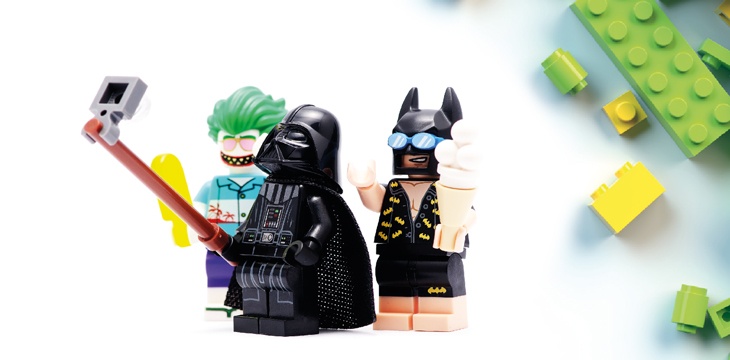I talk about Lego’s transformation with Lars Silberbauer
The first viewers of the 2014 Lego Movie, expecting to see a 2-hour commercial, will have been pleasantly surprised.
The Lego Movie is great. It’s closer in quality to Disney Pixar’s Inside Out than it is to Assassin’s Creed, despite it being closer in origin to the latter: both have migrated to TV from elsewhere.
Somewhere along the way, Lego transformed from a bricks-and-mortar plastics company (well, a plastic bricks company) into a formidable media presence.
I talked to Lars Silberbauer, Lego’s Global Senior Director, to establish how.
From Plastics to Digital
How did Lego transition from plastics to media?
‘I don’t think that that change actually happened at Lego. I think the change that happened was that the company became more focused on the play experience. That was the moment when I was brought into the company – when they went digital.’
‘The change that consumers have experienced in the last 10-15 years about going from traditional [toys]… to being mobile, tablet, social media [experiences]. When I came into the company seven years ago, there was no Facebook, there was no YouTube, there was nothing.’
‘They just hired me, not a big team. It was very much to look at the whole value chain and see how we can actually leverage these technologies and how we can create a roadmap on all of them. From recruitment to internal strategy to product development, to marketing to consumer service advocacy.’
‘I created eight lighthouses and said, "This is where we're going to be five years from now." But also make sure that we, on six-month basis, have very, very tangible projects and end results. Every month. To show every month that we are making progress and then making sure that we are communicating to the rest of the organisation.’
‘Then make sure the rest of the company knew in what context [my team’s output] should be understood. It's a mixture of both doing things [long-term] and doing things very, very rapidly. Also communicating to stakeholders and really making them understand and translating why this little thing means a lot on this journey that we're going on.’
From Ads to Experiences
Was the media or the plastics the bigger part of Lego now?
‘I think the core is still the play experience with Lego bricks. Everything else is meant to support that play experience. Of course, we’d like to have people watching Lego content instead of another brand’s content. Then they would hopefully get enticed and inspired to start building with Lego bricks.’
So internally then, in strategic value terms, did Lego conceptualise its considerable content assets primarily as advertising to drive brick sales?
Lars grimaced. I realised that I had said a dirty word.
‘I would rather use the word “experience”, rather than that word,’ he said.
‘Advertising’ said Lars, ‘is such a blunt way to make consumers interested in products. Customers don’t want adverts. I don’t want an advert for a product…I might welcome an experience with a specific product. If someone is just sending me a stupid advert, I think that’s old, traditional marketing.’
‘I think that's the change that we need to see: more happening in the marketing industry, because we are so focused on very traditional model, based on TV, based on broadcasting, about interrupting experiences. When they have the chance on digital platforms to block those ads, to block those commercials, then what?’
‘The only chance we have to actually deliver experiences is when consumers are welcoming. I think we're pretty far down that road. It's good for us that other companies are not, but I think that it's a big, important decision to make, the difference between adverts and experiences.’
Had Lars seen the Emoji Movie?
‘I missed that one.’
Lego’s is better, I said. I told Lars I admired that brand content could be daring and fun. The cardinal sin of all marketing everywhere is that it’s boring. Lots of companies have an immune system to cough interesting communications out.
‘I don’t think [that’s the problem], to be honest,’ said Lars. ‘The reason is…a lot of companies are still going into that space with an advertising mentality, and the advertising processes, built in. [If you] have the same mindset, and you still have the same processes in place, that delivers the same thing. If you take that mindset to an “experience” place, then you will deliver a crap experience.’
‘We can see that consumer behaviours have changed, radically. People are not sitting mindlessly in front of the TV. Now they're walking around like zombies with their mobile phone.’
‘It's a very different way of actually both interacting with media and interacting with platforms and interacting with other people.’
‘We have clients, advertisers, calling a creative agency and a media agency. If [the agencies] go away for months, spend millions of dollars and they come back with a pitch and then they say this is the key visual, or the hero film…that doesn't work in this space anymore.’
From Demographics to People
Had Lars seen Wendy’s on Twitter?
This time, yes.
Someone asked Wendy’s, “where to find the nearest McDonald’s?” and Wendy’s answered with a picture of a dustbin.
There’s hundreds of those kinds of interactions: Wendy’s social media manager is funny and interacts humanly with its audience. It generates attention: as the pop culture content website “boredpanda” points out, “Wendy’s is roasting people on Twitter, and it’s just too funny.”
But the half-life on that kind of thing is short. Were every film a brand experience, were every other Twitter account a brand trying to unctuously ingratiate itself with me by being “funny” or “out there,” it would get irritating – fast.
Lars shrugged. ‘Everything is competitive space. The vision in TV Land is competitive space…’
‘Everybody is [asking]…“What is the next formula? What is the next model?” The next model is going to be constant disruption. That’s what we do and what I always preach to both my teams.’
‘The core competence that we’re trying to develop is not about being the best at doing Facebook posts. That’s going to die away and then we’re going to have the next thing. The core competence that we try to develop is to be the best at adapting to leveraging and creating change.’
‘Make sure that everything we do can quickly be changed and that no one has an issue with letting go of things.’
‘I think… if you really want to start focusing on experiences, we should stop using these military terms like targeting, and pinpointing, overcoming an audience and pushing them. It might be that’s how it works, but if that’s the mentality that you have when you address your consumers, then I think you’re missing the point.’
‘I don’t want to be a demographic for whatever product I’m buying. It’s people, for God’s sake. They might have me in a database somewhere, but the more human the communication can be, the better. I think those human terms should be used more because that's how people want to be perceived. That's how I want to be perceived.’
Remaining “Lego”
Through all the change, would Lego retain a sense of itself? Lars had said it was still about the blocks – I wondered whether Lego’s balance sheets would have said the same thing.
Did they have exciting plans for augmented reality?
‘Can’t say.’
Ah.
‘You could look at the last Apple keynote,’ Lars suggested.
Previously, mentioning Lars’ interview to a member, they had suggested the company transition to become IKEA, I said. Lego furniture, Lego houses. Perhaps that was the next step.
‘Well, we just launched a partnership with IKEA last week,’ said Lars.
Is Lego furniture on the way?
‘I don't know. I don't think so. I think IKEA does furniture, we do play experiences.’
Lars had become opaque.
I left sceptical about Lars’ contention that marketing could be fully welcomed by customers; at least not for every company. There’s a mathematics to marketing – a pursued, and a pursuer.
I did leave impressed with his appetite for disruption:
‘We might have been really good at Vine videos,’ Lars had said. ‘Vine went down the drain. Just let it go, it's over. Move on to the next thing. I think that's difficult for humans, and difficult for professionals.’
‘If you're the best at practicing jumping, you want to see more hurdles in front of you. You want to see more obstacles, because you know that your competitors are going to struggle with it. We practice changing, we practice jumping, because we know it's going to put everyone else under pressure.’




Leave a Comment